Bookshelf Bench Building Plans
2 minutes
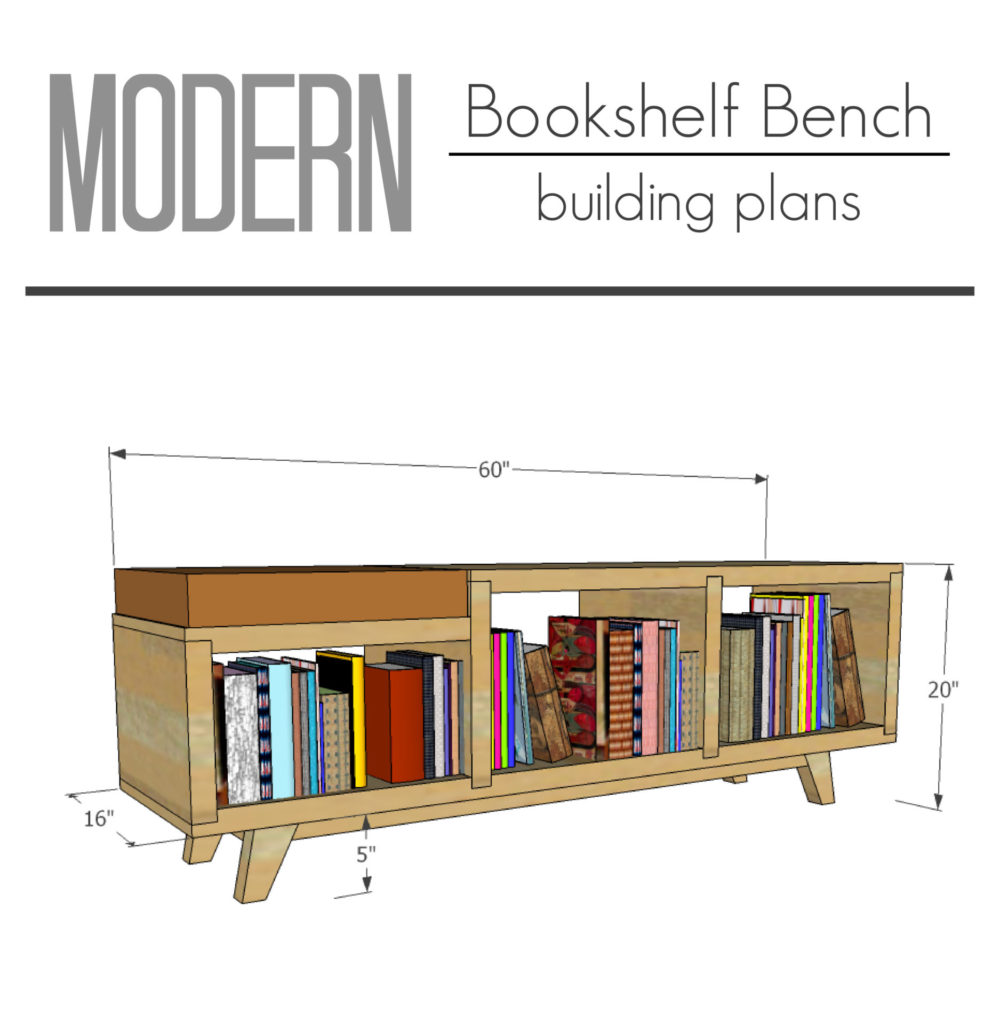
This bench was built completely on a SawStop Jobsite Pro. It offers much needed storage while looking stylish and flexible enough to work within any room in your house. Follow the step-by-step instructions below on how to customize the bench to your exact needs.
Furniture building comes with inherent risk. Use caution when handling and operating tools. Before starting the project, make sure you are familiar with safe operating procedures. Follow manufacturer’s recommendations for all products and equipment used.
Step 1: Top and Bottom Panels
Preparation
To join stock, plane, square, and glue-up edges to create 16” wide panels. I used 1-½” thick poplar hardwood boards because it is easy to work with — and I had plenty on hand.
Alternative: Consider plywood panels if you want to save time preparing the material or prefer a more rustic aesthetic. Note, you will still need to glue up the panels to create 1-½” substrate. To do this, simply rip ¾” plywood sheets into 16” wide strips. Laminate pairs of strips together to create 1-1/2” thick panels. From your prepared material cut one 41-1/2” length panel and one 60” length panel.
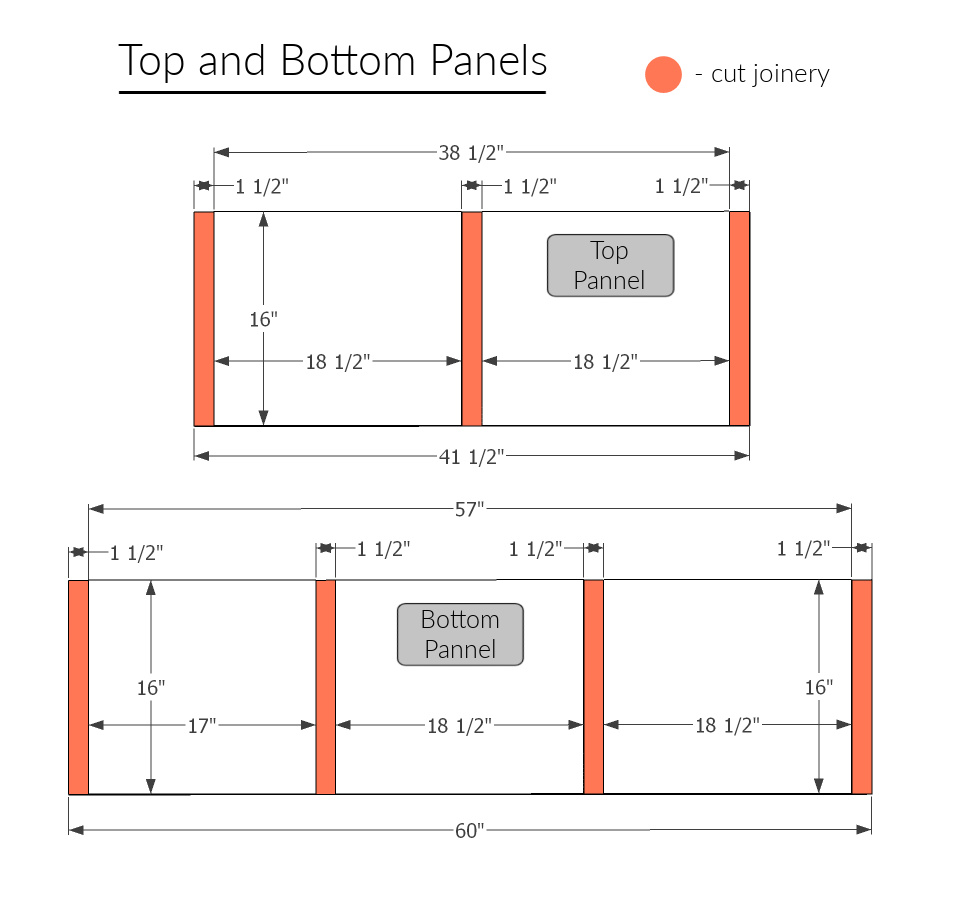
Create Rabbet Joinery
Rabbet joints require a modest level of skill and effort and are an efficient way to add strength and style to the piece. Before marking -up the panels, take a moment to consider if there is character in the wood that you want to feature (or flaws to conceal). Of course, the most visible side of the top panel will be opposite the side of the rabbets, while the most visible side of the bottom panel will be the side with the rabbets.
Top Panel (41.5” x 16”)
Using your preferred method (I used the table saw) cut 16” x 1-1/2” x 3/4” rabbets flush to both ends. Then measure 18-1/2” from the inside cheek of both rabbets. Create a 16”x1-1/2”x3/4” dado, centered on the panel.
Bottom Panel (60” x 16”)
Using your preferred method cut 16” x 1-1/2” x 3/4” rabbets flush to both ends. Create two additional 16” x 1-1/2” x 3/4” dados at 18-1/2” from the inside cheek of an end rabbet and 17” from the inside cheek of the opposite rabbet (FYI: the seat will be located on the 17” side).
Step 2: Vertical Dividers & Horizontal Seat Support
Prepare Dividers
The dimensions of the vertical dividers will also be 1-½“ thick and 16” deep. Like the top and bottom panels, use 1-½” thick hardwood boards, joint edges, plane, and join together to create 16” wide panels.
Alternative: If you’ve elected to use plywood panels, rip ¾” plywood sheets into 16” wide strips. Laminate pairs of strips together to create 1-1/2” thick panels.
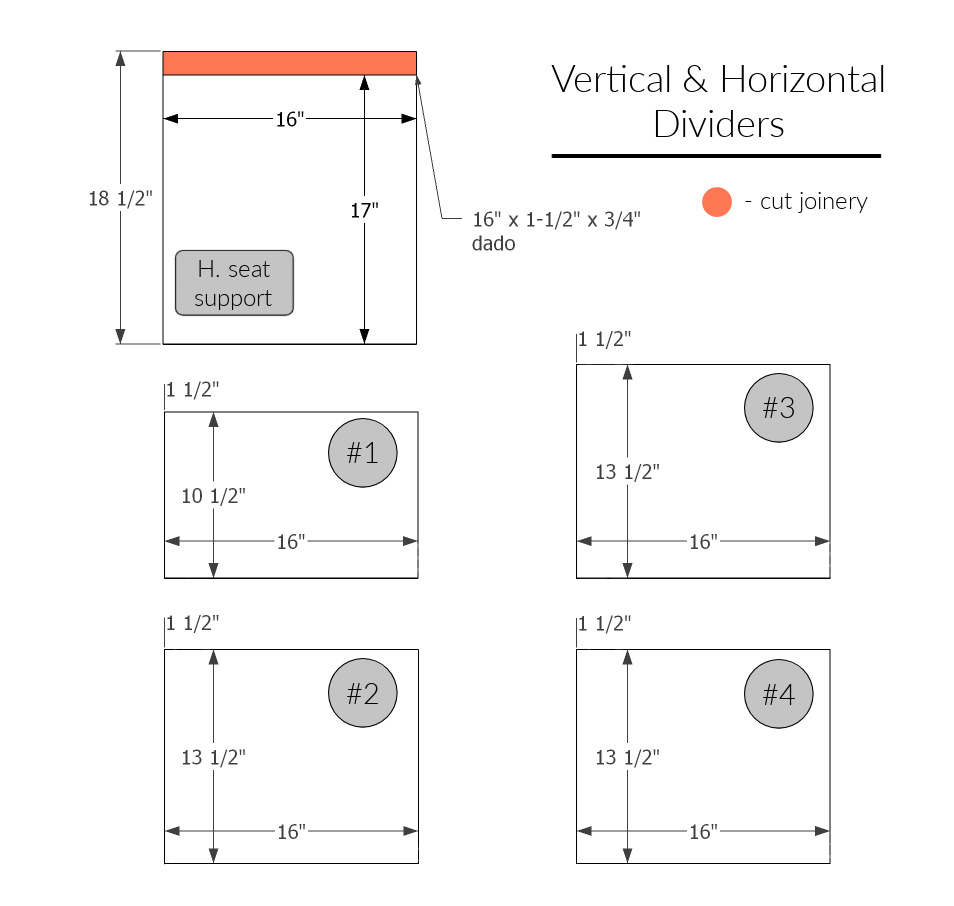
Cut to Length
From your prepared material cut (3) 13-1/2” length Vertical Dividers, (1) 10-1/2” length Vertical Divider, and (1) 18-1/2” length Horizontal Seat Support.
Create Rabbet Joinery for Seat Support
The 16” x 18-1/2” panel is the Horizontal Seat Support. Using your preferred method cut a 16”x1-1/2”x3/4” rabbet flush to one end.
Step 3: Base Legs
Prep
Using prepared material, cut (4)
5” x 5” x 1-1/2” blocks.
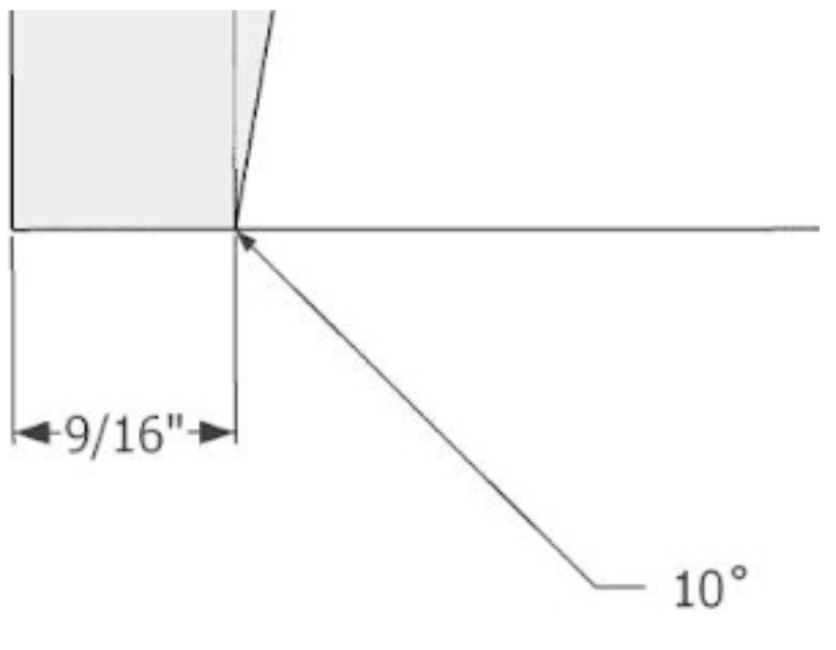
Outside Leg Angle
Make a reference mark 9/16” in from the lower left corner. From this mark, use a table saw with miter gauge or cross-cut sled to cut 10o off square from the bottom corner to the top edge as shown.
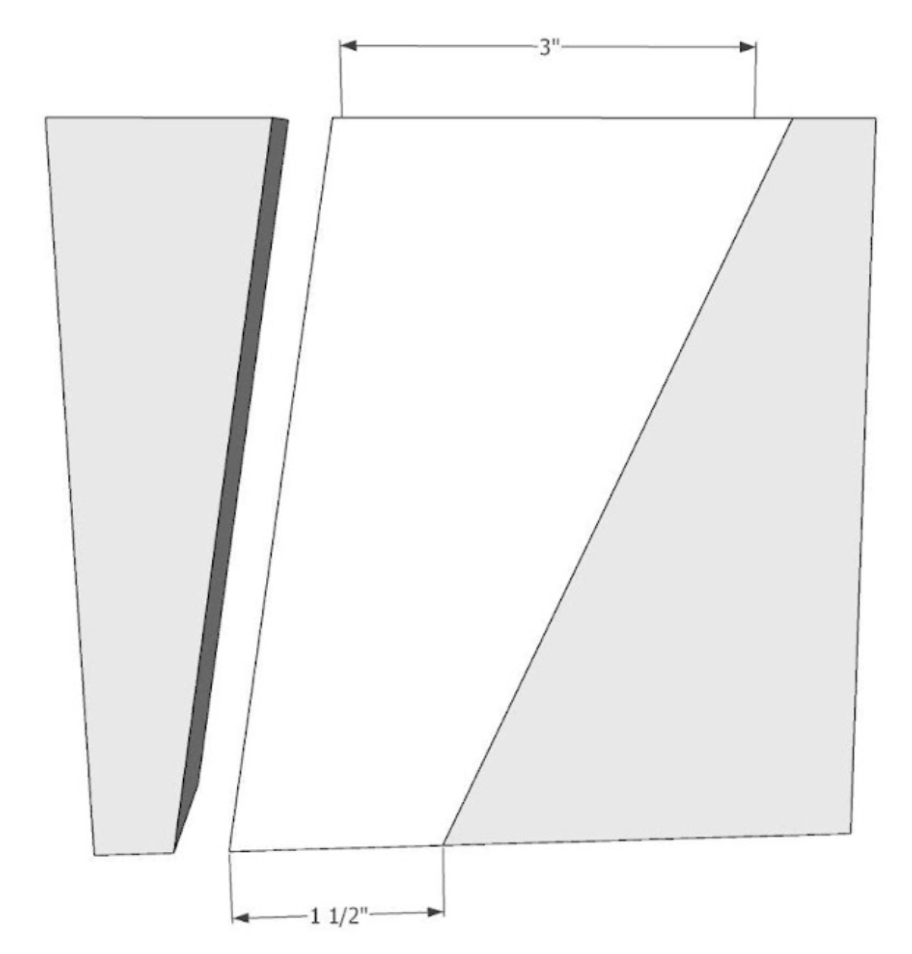
Inside Leg Angle
Measure 3” along the top and 1-1/2” along the bottom edges. Use a straight edge and pencil to connect these points. Use a table saw with miter gauge or cross-cut sled to cut along this line.
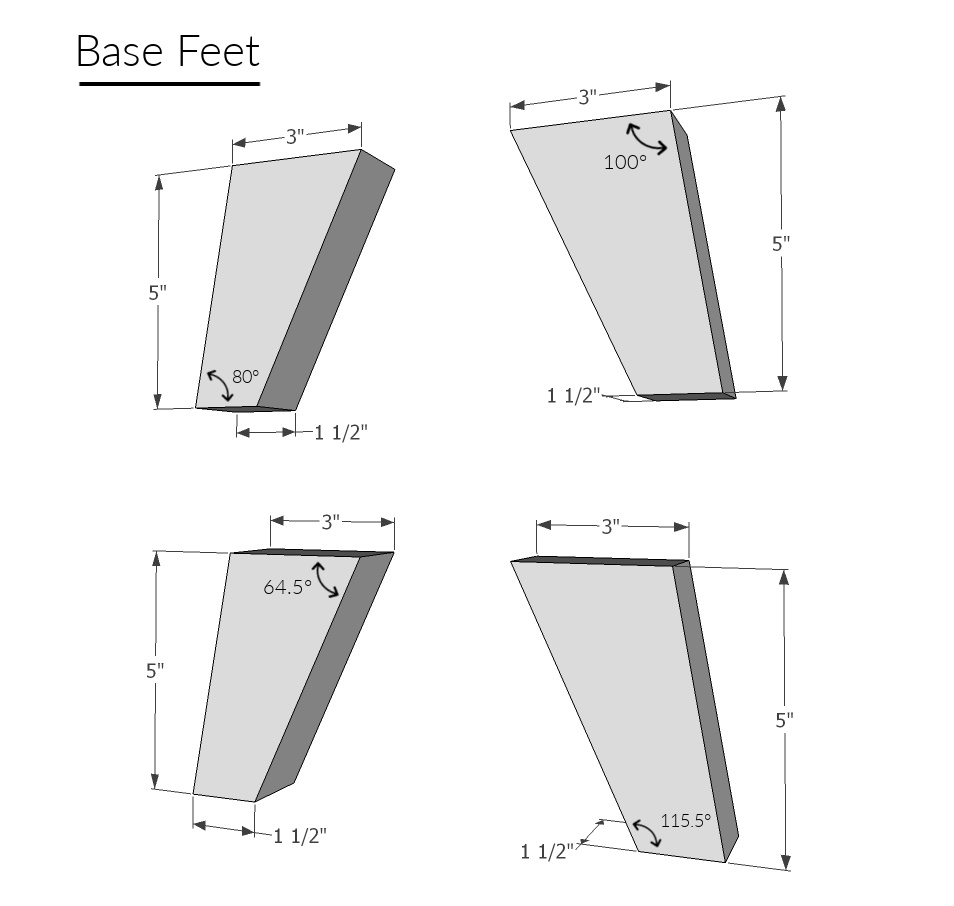
RESULT
Step 4: Base Stretchers
Prepare Long-Side Stretchers (44” x 1-½” x 1-½”)
Cut (2) 1-1/2” x 1-1/2” boards greater than 44” long out of prepared material.
Scribe Base Leg Angle to Long-Side Stretchers
Match the top edges of base legs to the ends of the Long Side Stretchers. Spaced 42” apart, use a pencil to a scribe the intersecting angle on to the stretchers and cut.
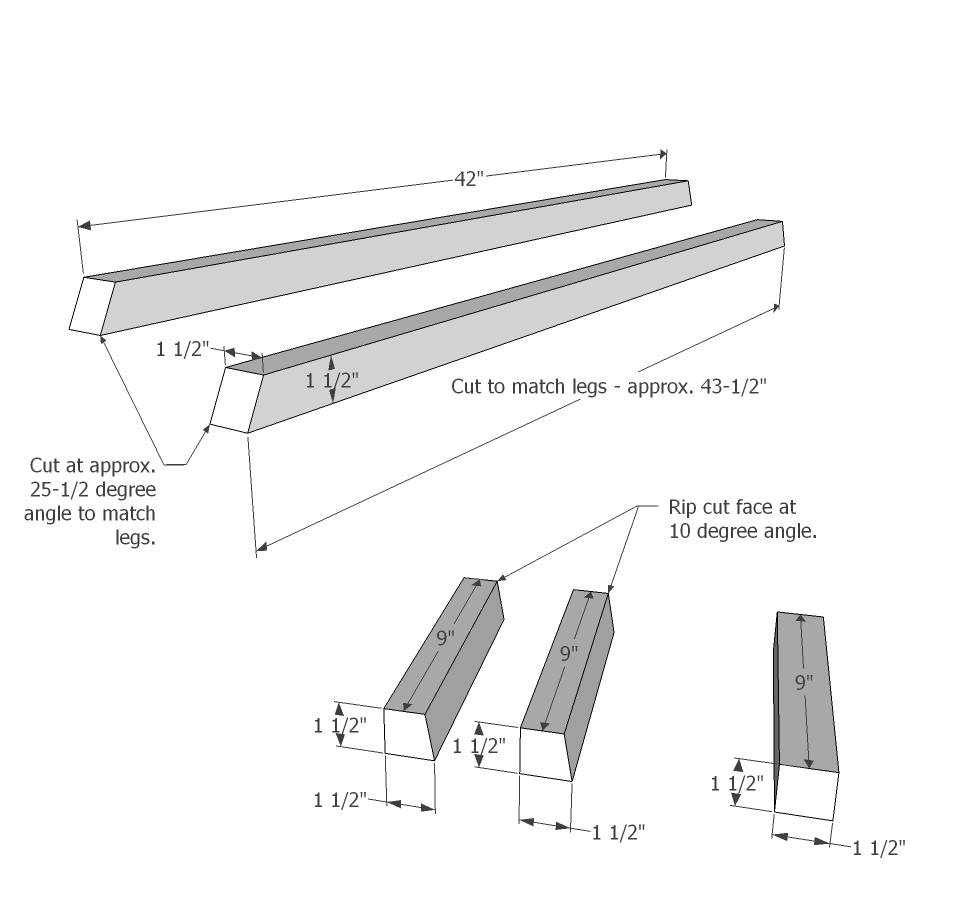
Cut Short-Side Stretchers (9” x 1-½” x 1-½”)
Create Short Side Base Stretchers by cutting (3) 9”x1-1/2”x1-1/2” boards out of prepared material. Set one stretcher aside for center support. Using a table saw, rip cut the two remaining stretchers 10o off square on a long side to match Base Leg angle.
Step 5: Seat Assembly
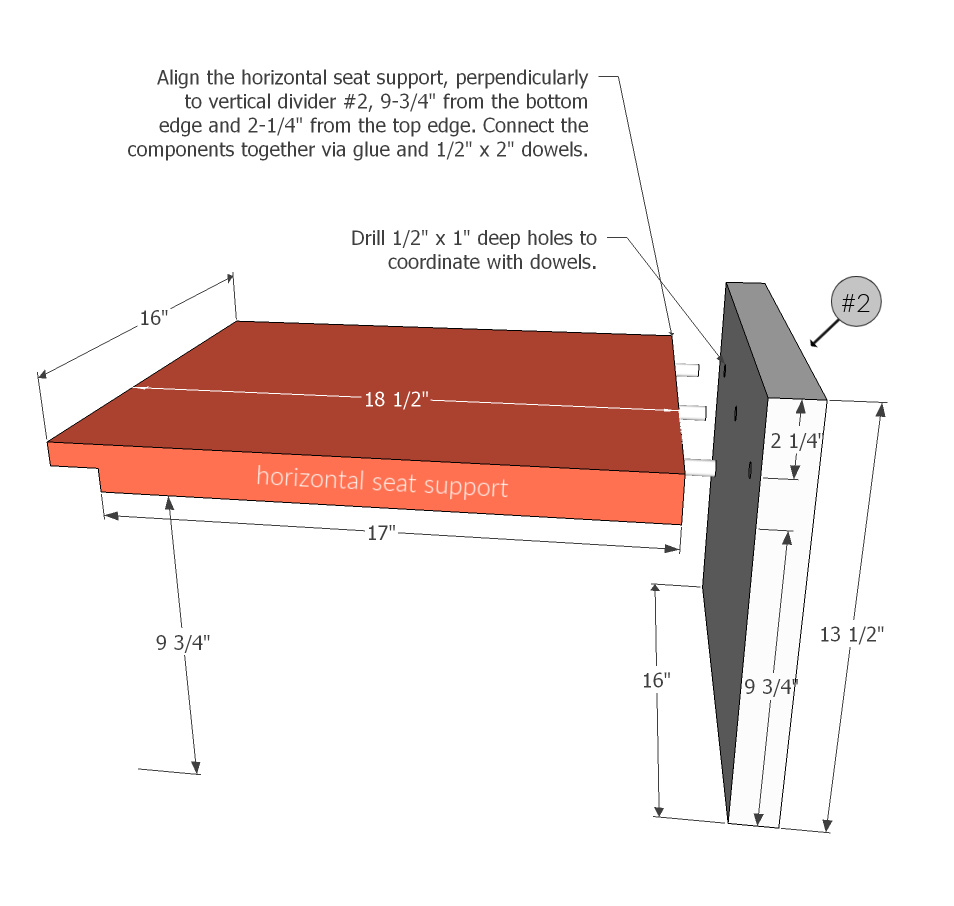
Align the horizontal seat support, perpendicularly to vertical divider #2, 9-3/4″ from the bottom edge and 2-1/4″ from the top edge. On the intersecting edge of the seat support and face of the divider, mark the location for 3, ½” dowels. Drill coordinating 1/2″ x 1″ holes in marked dowel locations. Connect components together via wood glue and 1/2″ x 2″ dowels. Apply clamps to hold components together and set seat assembly aside to allow glue to cure.
Step 6: Vertical Dividers
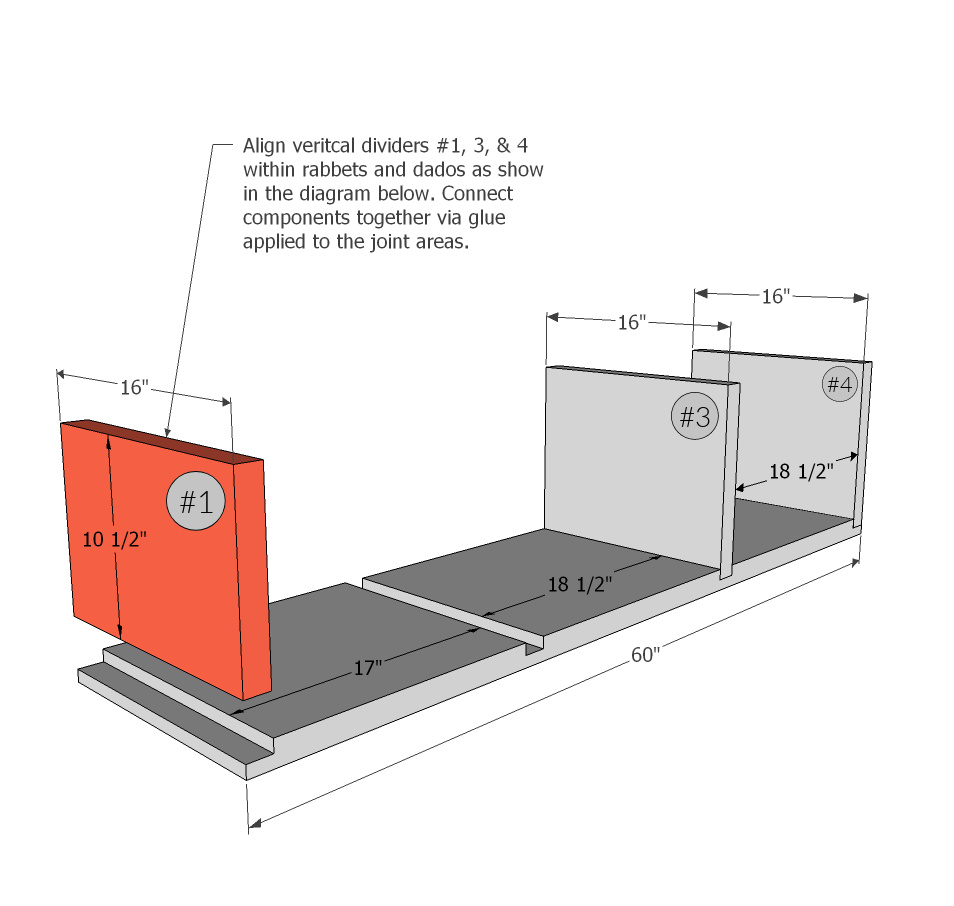
Align vertical dividers #1, 3, & 4 within rabbets and dados as show in the diagram below. Connect components together via glue applied to the joint areas. Apply clamps to hold components together while glue cures.
Step 7: Attaching Seat
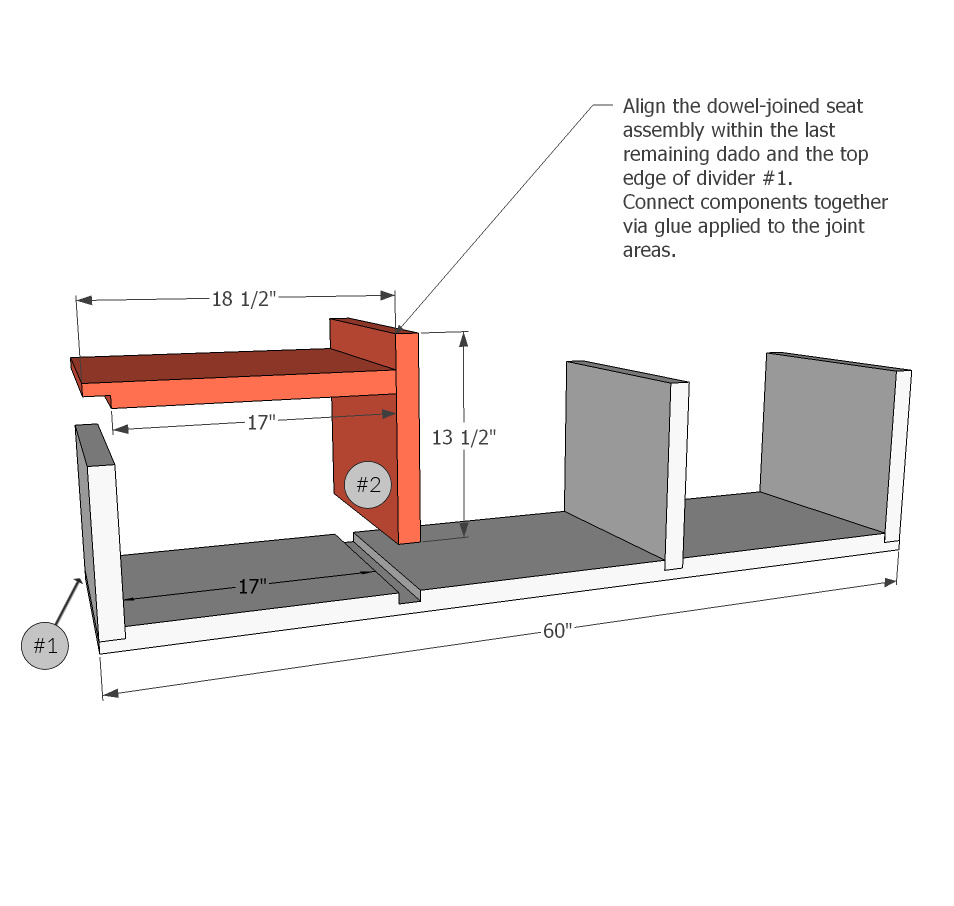
Once fully cured, align the dowel-joined seat assembly within the last remaining dado and flush to the top edge of divider #1. Connect components together via glue applied to the joint areas. Apply clamps to hold components together while glue cures.
Step 8: Top Panel
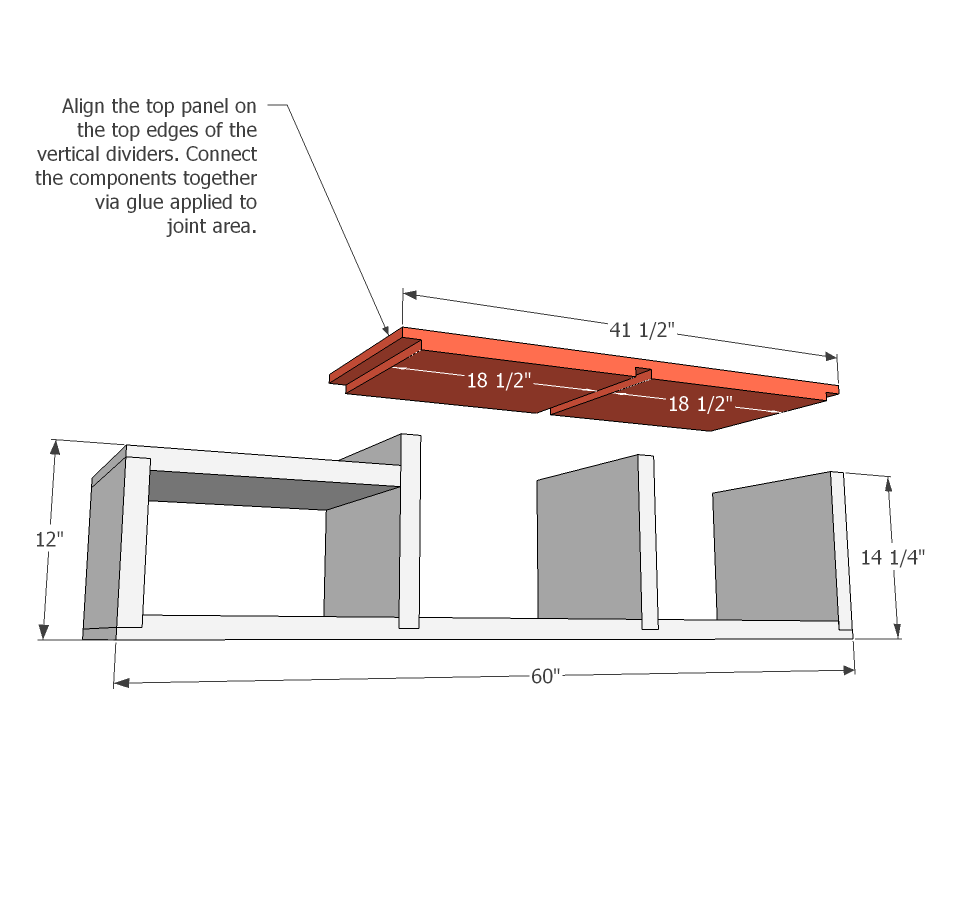
Align the top panel onto the top edges of vertical dividers. Connect the components together via glue applied to joint area. Apply clamps to hold components together while glue cures.
Step 9: End Leg Assemblies
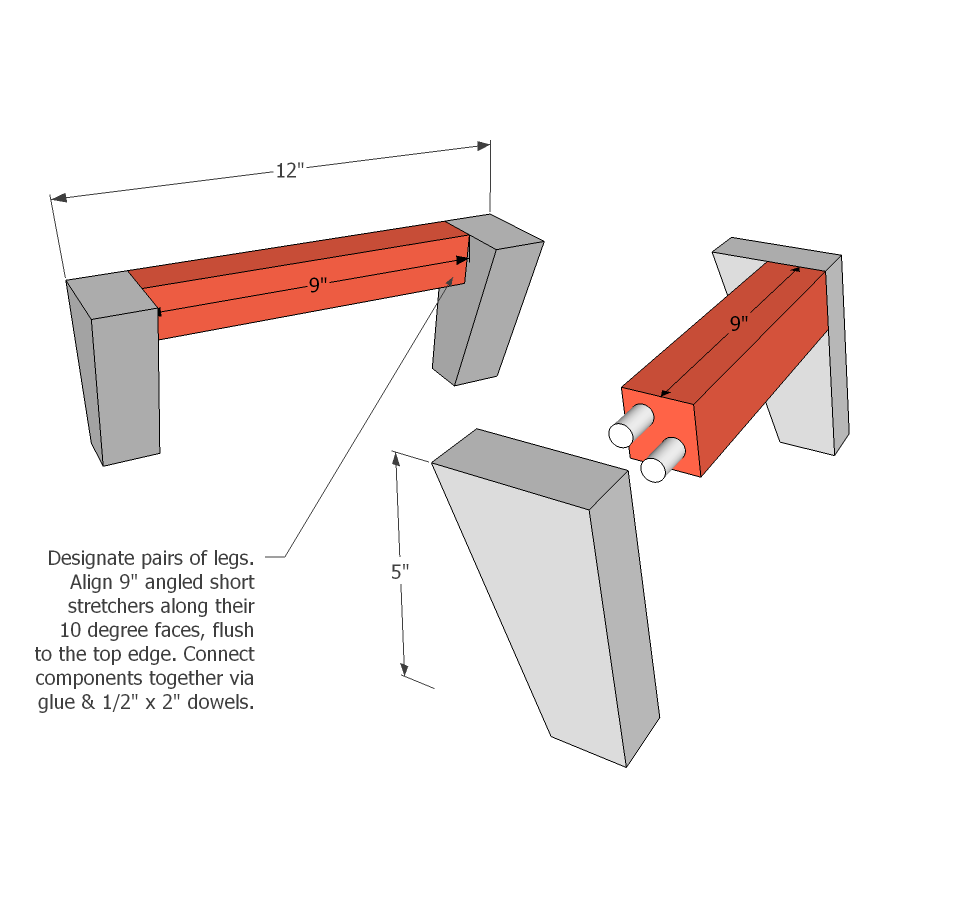
Designate pairs of legs to be connected together. Between each pair of legs, align a 9″ angled short stretcher along their 10° faces, flush to the top edge. Connect components together via glue & 1/2″ x 2″ dowels. Apply clamps and allow the glue to fully cure.
Step 10: Center Stretcher
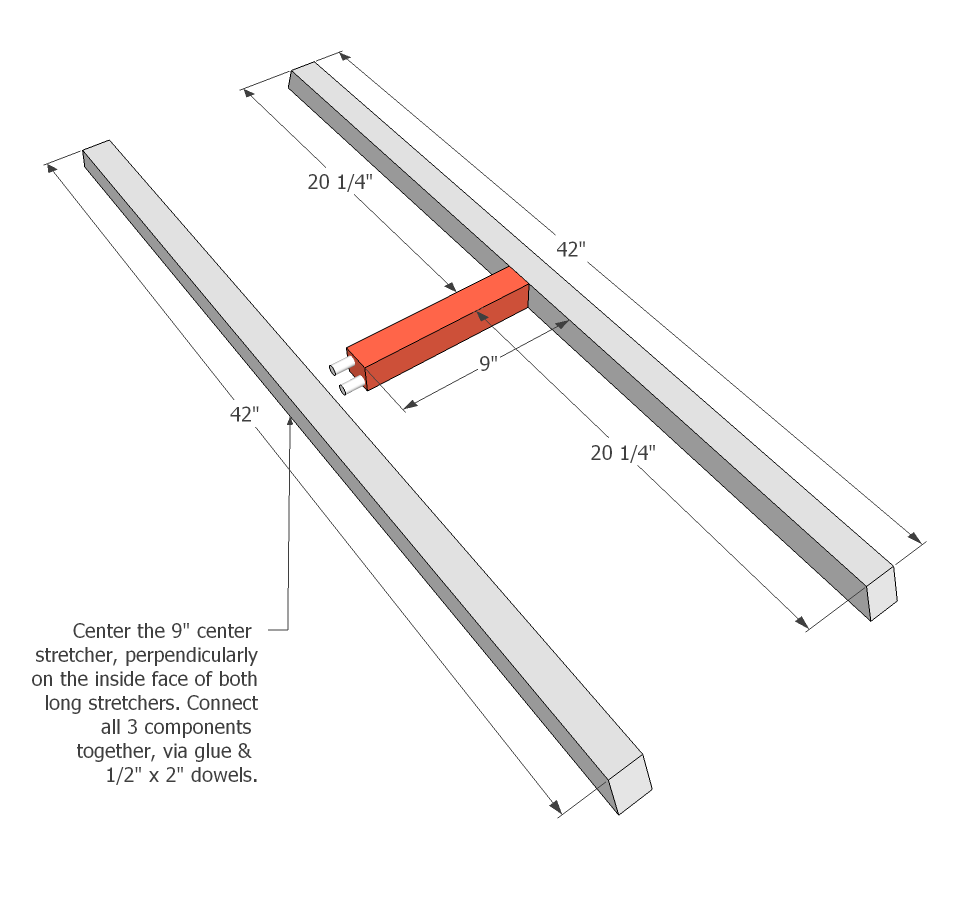
Center the 9″ center stretcher, perpendicularly on the inside face of both long stretchers. Connect all 3 components together, via glue & 1/2″ x 2″ dowels. Apply clamps and allow glue to fully cure.
Step 11: Connect Leg Assemblies to Stretchers
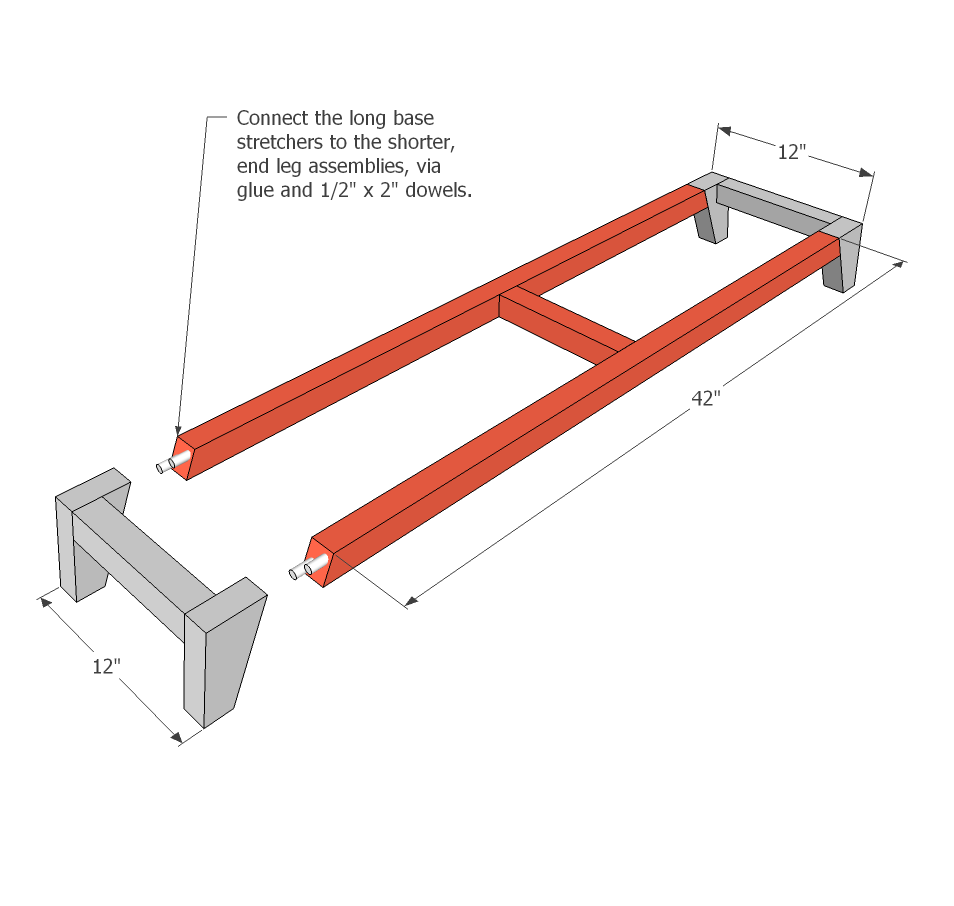
Connect the long base stretchers to the shorter end leg assemblies, via glue and 1/2″ x 2″ dowels. Apply clamps and allow glue to fully cure.
Step 12: Connect Base to Box
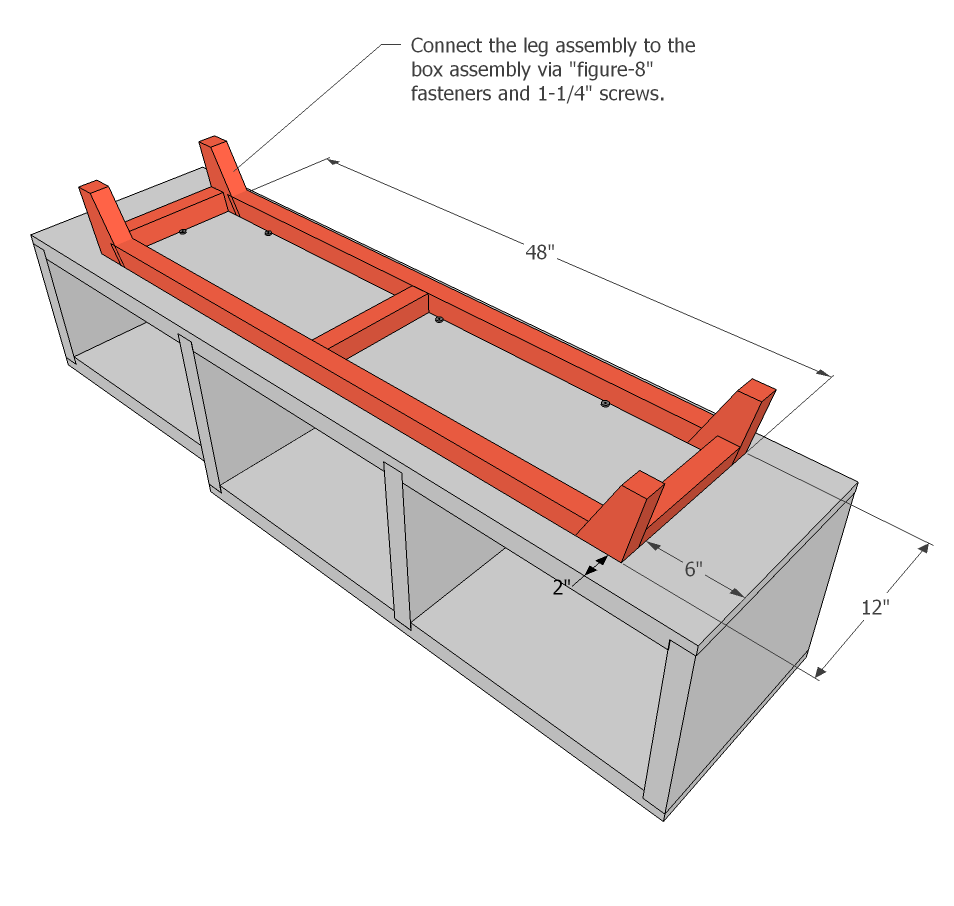
Carefully, flip the box assembly top-side down onto a soft worksurface. Invert the base assembly onto the bottom face of the bottom panel, spaced 2” from the long sides of the box and 6” from either end. Connect the base assembly to the box assembly via “figure-8” fasteners and 1-1/4” screws.
Step 13: Add Cushion
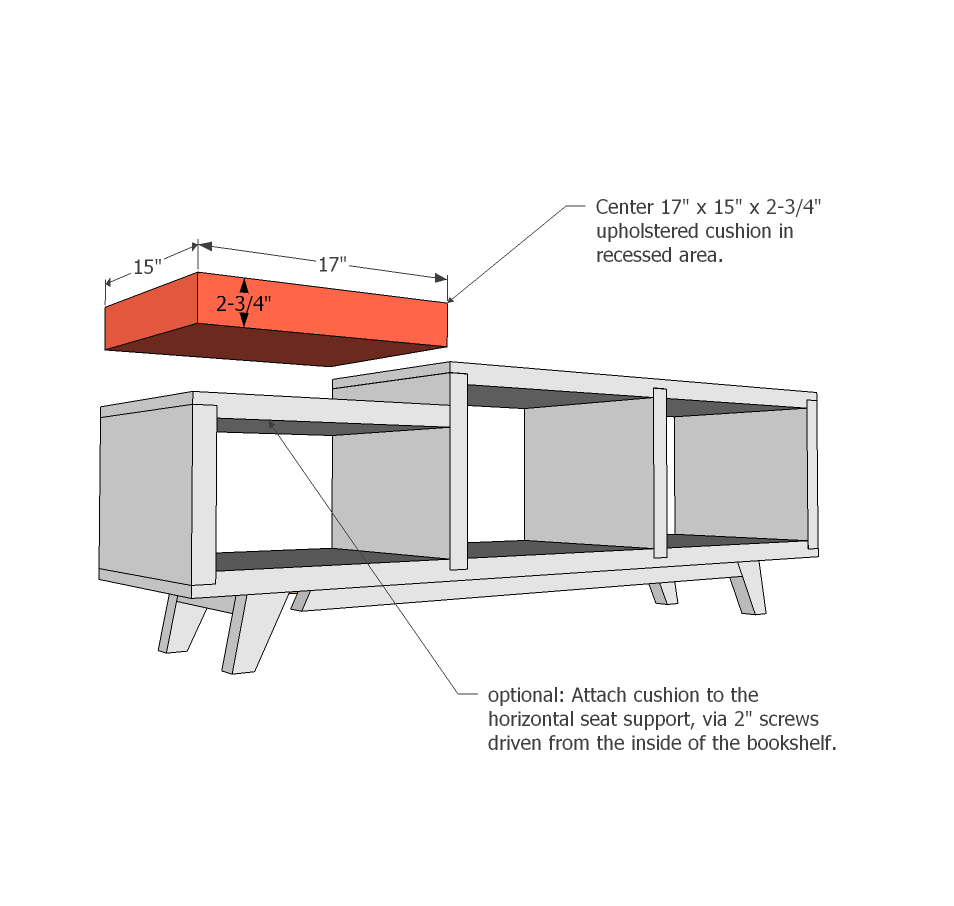
Center a 17″ x 15″ x 2-3/4″ upholstered cushion in recessed seat area.
Optional: Attach cushion to the horizontal seat support, via 2″ pre-drilled screws driven from the inside of the bookshelf.
Step 1: Top and Bottom Panels
Preparation
To join stock, plane, square, and glue-up edges to create 16” wide panels. I used 1-½” thick poplar hardwood boards because it is easy to work with — and I had plenty on hand.
Alternative: Consider plywood panels if you want to save time preparing the material or prefer a more rustic aesthetic. Note, you will still need to glue up the panels to create 1-½” substrate. To do this, simply rip ¾” plywood sheets into 16” wide strips. Laminate pairs of strips together to create 1-1/2” thick panels. From your prepared material cut one 41-1/2” length panel and one 60” length panel.

Create Rabbet Joinery
Rabbet joints require a modest level of skill and effort and are an efficient way to add strength and style to the piece. Before marking -up the panels, take a moment to consider if there is character in the wood that you want to feature (or flaws to conceal). Of course, the most visible side of the top panel will be opposite the side of the rabbets, while the most visible side of the bottom panel will be the side with the rabbets.
Top Panel (41.5” x 16”)
Using your preferred method (I used the table saw) cut 16” x 1-1/2” x 3/4” rabbets flush to both ends. Then measure 18-1/2” from the inside cheek of both rabbets. Create a 16”x1-1/2”x3/4” dado, centered on the panel.
Bottom Panel (60” x 16”)
Using your preferred method cut 16” x 1-1/2” x 3/4” rabbets flush to both ends. Create two additional 16” x 1-1/2” x 3/4” dados at 18-1/2” from the inside cheek of an end rabbet and 17” from the inside cheek of the opposite rabbet (FYI: the seat will be located on the 17” side).
Step 2: Vertical Dividers & Horizontal Seat Support
Prepare Dividers
The dimensions of the vertical dividers will also be 1-½“ thick and 16” deep. Like the top and bottom panels, use 1-½” thick hardwood boards, joint edges, plane, and join together to create 16” wide panels.
Alternative: If you’ve elected to use plywood panels, rip ¾” plywood sheets into 16” wide strips. Laminate pairs of strips together to create 1-1/2” thick panels.

Cut to Length
From your prepared material cut (3) 13-1/2” length Vertical Dividers, (1) 10-1/2” length Vertical Divider, and (1) 18-1/2” length Horizontal Seat Support.
Create Rabbet Joinery for Seat Support
The 16” x 18-1/2” panel is the Horizontal Seat Support. Using your preferred method cut a 16”x1-1/2”x3/4” rabbet flush to one end.
Step 3: Base Legs
Prep
Using prepared material, cut (4)
5” x 5” x 1-1/2” blocks.

Outside Leg Angle
Make a reference mark 9/16” in from the lower left corner. From this mark, use a table saw with miter gauge or cross-cut sled to cut 10o off square from the bottom corner to the top edge as shown.

Inside Leg Angle
Measure 3” along the top and 1-1/2” along the bottom edges. Use a straight edge and pencil to connect these points. Use a table saw with miter gauge or cross-cut sled to cut along this line.

RESULT
Step 4: Base Stretchers
Prepare Long-Side Stretchers (44” x 1-½” x 1-½”)
Cut (2) 1-1/2” x 1-1/2” boards greater than 44” long out of prepared material.
Scribe Base Leg Angle to Long-Side Stretchers
Match the top edges of base legs to the ends of the Long Side Stretchers. Spaced 42” apart, use a pencil to a scribe the intersecting angle on to the stretchers and cut.

Cut Short-Side Stretchers (9” x 1-½” x 1-½”)
Create Short Side Base Stretchers by cutting (3) 9”x1-1/2”x1-1/2” boards out of prepared material. Set one stretcher aside for center support. Using a table saw, rip cut the two remaining stretchers 10o off square on a long side to match Base Leg angle.
Step 5: Seat Assembly

Align the horizontal seat support, perpendicularly to vertical divider #2, 9-3/4″ from the bottom edge and 2-1/4″ from the top edge. On the intersecting edge of the seat support and face of the divider, mark the location for 3, ½” dowels. Drill coordinating 1/2″ x 1″ holes in marked dowel locations. Connect components together via wood glue and 1/2″ x 2″ dowels. Apply clamps to hold components together and set seat assembly aside to allow glue to cure.
Step 6: Vertical Dividers

Align vertical dividers #1, 3, & 4 within rabbets and dados as show in the diagram below. Connect components together via glue applied to the joint areas. Apply clamps to hold components together while glue cures.
Step 7: Attaching Seat

Once fully cured, align the dowel-joined seat assembly within the last remaining dado and flush to the top edge of divider #1. Connect components together via glue applied to the joint areas. Apply clamps to hold components together while glue cures.
Step 8: Top Panel

Align the top panel onto the top edges of vertical dividers. Connect the components together via glue applied to joint area. Apply clamps to hold components together while glue cures.
Step 9: End Leg Assemblies

Designate pairs of legs to be connected together. Between each pair of legs, align a 9″ angled short stretcher along their 10° faces, flush to the top edge. Connect components together via glue & 1/2″ x 2″ dowels. Apply clamps and allow the glue to fully cure.
Step 10: Center Stretcher

Center the 9″ center stretcher, perpendicularly on the inside face of both long stretchers. Connect all 3 components together, via glue & 1/2″ x 2″ dowels. Apply clamps and allow glue to fully cure.
Step 11: Connect Leg Assemblies to Stretchers

Connect the long base stretchers to the shorter end leg assemblies, via glue and 1/2″ x 2″ dowels. Apply clamps and allow glue to fully cure.
Step 12: Connect Base to Box

Carefully, flip the box assembly top-side down onto a soft worksurface. Invert the base assembly onto the bottom face of the bottom panel, spaced 2” from the long sides of the box and 6” from either end. Connect the base assembly to the box assembly via “figure-8” fasteners and 1-1/4” screws.
Step 13: Add Cushion

Center a 17″ x 15″ x 2-3/4″ upholstered cushion in recessed seat area.
Optional: Attach cushion to the horizontal seat support, via 2″ pre-drilled screws driven from the inside of the bookshelf.
Supplies
- Poplar Lumber – Optional Plywood
- 19 – 1/2″x2″ Hard Wood Dowels
- 6 – figure-eight fasteners
- 8 – #8 – 1- 1/4″ wood screws
- 1-1/4” brad nails
- Wood glue
- 17” x 15” x 2-3/4” upholstered foam seat cushion
Required Tools
- SawStop 10” Jobsite Pro Table saw
- Cordless Drill
- Bar Clamps
- Measuring Tape
- Speed Square
- Drill Bits ⅛” & ½”
Optional Tools
- Circular Saw or Track Saw
- Brad Nailer
- Doweling Jig
- Glue Spreader
- Crosscut Sled
CONTRIBUTER
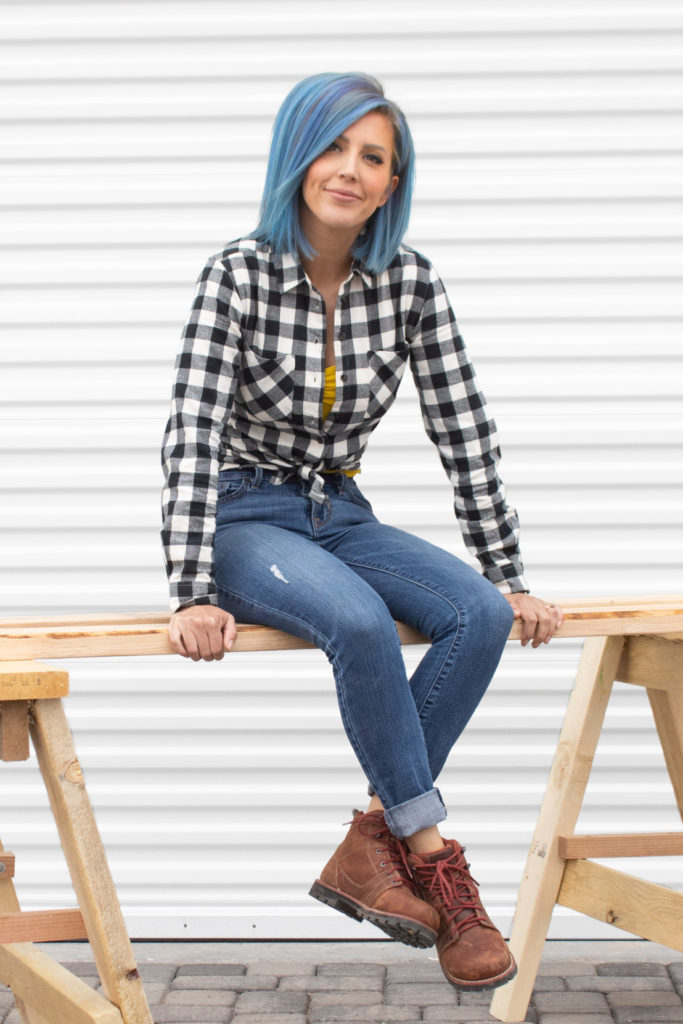
Hello! I’m Elisha Albretsen, the DIYer behind Pneumatic Addict. I grew up in a handy but humble household and was always helping Mom or Dad work to beautify our home. I’ve always been a “Maker” but didn’t learn to wield power tools until 2011, when the financial recession and a growing family forced me to look for new ways to earn a living. I’ve been building and blogging about DIY Furniture and Home Improvement ever since. These days, I can usually be found in the garage, covered in sawdust, or behind the computer, drafting up a new set of building plans. In 2020, my family and I took on our largest project to date – building a modern home and dream workshop ourselves in suburban Arizona. If you’re interested in learning more about building a contemporary home on a budget, or want to score free building plans for dozens of unique projects, make sure to visit my website www.pneumaticaddict.com and check out the Pneumatic Addict YouTube channel.
